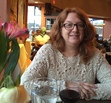K. Heidi Fishman's Blog, page 5
November 16, 2016
Spiersfelde

A few years ago I was looking through my grandmother’s photo album. One of the most striking pictures shows thirty-one people in a group portrait. They are nicely dressed and posed in a purposeful composition with the family patriarch and his wife, my great-great-grandparents, sitting in the center.
My grandmother stands slightly to one side – a teenager. I imagine that she was less than enthused about taking the time to pose for the photo session, just as my 17 year old would be today.
I don’t know the occasion that brought all these people, mostly relatives I assume, together. I believe it was the early 1920s. I can only identify a handful of them. There is a large estate in the background. It was, and still is, named Spiersfelde — Spier’s Fields. Spier being the family name.
Two weeks ago I stood on the same spot where the photographer stood for that group portrait and I took a picture. The large house still stands with its stately façade. I imagined my relatives gathering that day and wondered what they were celebrating. Was it a special birthday, a national holiday, an anniversary? I’m sure it was a special day for them. And I am positive that none of them could foresee that twenty years later most of them would be murdered and that none of them, nor any of their descendants, would be living at Spiersfelde.
While I stood there with my mother, she showed a glimmer of nostalgia and emotion. That’s something she usually tries to avoid. I asked her what she was feeling and she replied, “I wonder what life would have been like if the war hadn’t happened.”
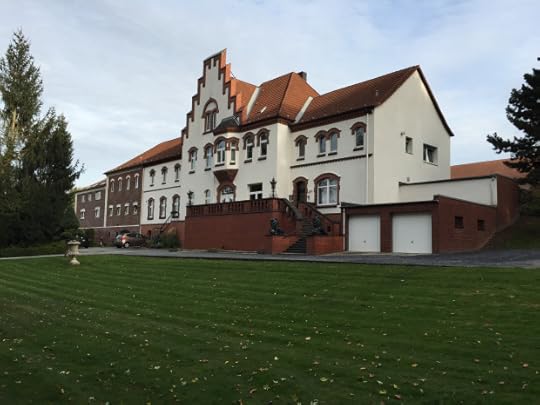
Filed under: Connections, Memory Tagged: family, History, Spier, Spiersfelde, Wickrath








September 23, 2016
Dicey Splicing

This spring Tutti’s Promise will be published as a paperback and in e-book format. I love the idea of saving paper and lightening the loads in kids’ backpacks. It seems everyone has a iPad or a Nook or some sort of e-reader. Even my 88 year old father reads on a Kindle.
One advantage of the electronic version of Tutti’s Promise will be the embedded videos. My publisher has tasked me with picking clips from my mother’s Shoah Foundation testimony to pair with various scenes in the book. The wonderful thing is that the entire testimony is available through the iWitness site. iWitness is a phenomenal teaching tool that any teacher can tap into.
I discovered this week that video editing is not quite as easy as one might expect. After spending the better part of two days on my first clip, I have new-found respect for all those people that work behind the scenes in movie studios. I had to teach myself how to download, upload, splice and add transitions. The transitions are the tricky part. If you do it wrong the two pieces of film merge over each other or can contain extra moments in the final cut that you don’t want. I found the task took immense patience (a virtue I am not known to possess a lot of) and precision in mouse clicking.
Here is my first video – I should have counted how many hours it took me to create this one and a half minute video. It isn’t perfectly edited yet, but I hope you enjoy it!
Filed under: Holocaust, Testimony Tagged: e-books, iPad, Kindle, Nook, print on demand, Publishing, Shoah Foundation, Video Editing








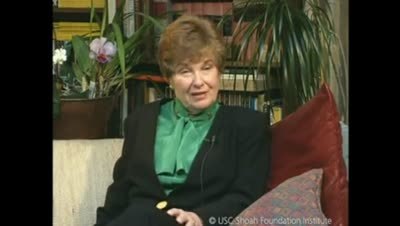
August 30, 2016
Stumbling on the Stumbling Stones
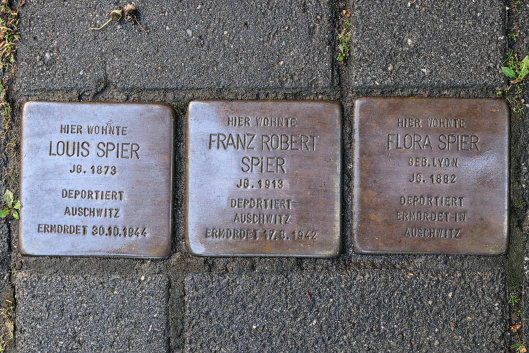 Gunter Demning is a German artist who has made a name for himself installing stolpersteine (translation – stumbling stones) in front of the final residences of Holocaust victims. I was lucky enough to be invited to help set the stolpersteine for my great uncle and his wife in Tilburg in January 2014.
Gunter Demning is a German artist who has made a name for himself installing stolpersteine (translation – stumbling stones) in front of the final residences of Holocaust victims. I was lucky enough to be invited to help set the stolpersteine for my great uncle and his wife in Tilburg in January 2014.
This past weekend I was looking online for a good picture of my great-grandparents’ stolpersteine in Wickrath, Germany. I was hoping to find one to include in Tutti’s Promise. I did find a picture, and when I went to its webpage I found an article that mentioned the Historical Society of Wickrath was going to be doing an Exhibition about the Spier family. Wow! The local historians were digging into my family history. I spent a little more time and was able to find a contact email and now I am in touch with the people who are organizing the exhibit. They have already sent me some pictures I have never seen before.
I believe Demning’s intention with the stolpersteine project was to remind us all to remember the dead and to remember the destruction that was wrought by the prejudice of the Nazis. I wonder if he knows that he is bringing people together, not only to share memories, but also to learn new things and make new friends.
Filed under: Connections, Holocaust, Memory, Nazi, Prejudice Tagged: Commonality, connections, Gunter Demning, Research, Spier, Stolperstein, Wickrath








August 4, 2016
The Value of a Life
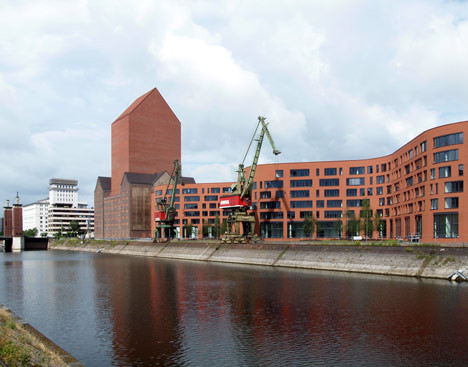
After finding out at the International Tracing Service in Bad Arolsen that there were Gestapo files on several of my relatives I was very excited that our next stop was Duisburg. This is where the State of North Rhine Westfalia (NRW) Archives are located. The building is on the waterfront of the inner harbor of the city and is a massive red brick building. I found it somewhat beautiful and off putting all at once.
Once inside, we were directed to the reading room which was unexpectedly light-filled and airy with large windows all along one wall. Since I had contacted the NRW ahead of time, they had my requested files ready and waiting. I signed in, was handed a large stack of folders, and told to sit in a certain section of the reading room while looking through them.
Most of the files I was looking at were from after the war. There were numerous letters from attorneys. These files represented what was left after the Germans had stolen everything from my family members – both from their personal accounts and belongings and from their businesses. In the late 1940s and even into the 1950s my grandparents were trying to reclaim what had been taken from them and their parents. This was not a straightforward procedure as various entities had more than one claimant due to the way the Germans took over businesses, sold them to different owners – who actually paid for them – but then ended up with stolen property. Most of the pages I simply couldn’t understand as the German legal vocabulary wasn’t covered in German 101. But I could see that it took years of fighting for my grandparents to get something back.
While I was leafing through the numerous folders filled with all the reparation information, my husband went through the books which contained the Gestapo file information so we could ask the archivists to pull the files we had just learned about the day before. We were lucky to be able to get these files before we left and I was shocked to find out that they dated from 1938 – two years after the family had left Germany.
In these files there were letters between the Gestapo offices in Dusseldorf and the Niederrheinische Actien-Gesellschaft für Lederfabrikation (The Lower Rhine Corporation – Company for Leather Fabrication). This was the new name of my great-great-grandfather’s (Zacharias Spier) leather factory in Wickrath, Germany after the Germans aryanized it. My great grandfather, Louis Spier, who worked for his father, wanted the deed of his confiscated home. The Germans wanted an accounting of all of Louis’ assets. The Gestapo was delineating the “Aberkennung der deutschen Staatsangehörigkeit des Juden” – the withdrawal of German citizenship of the Jew – Louis Spier, born the 9th of November 1873 in Wickrath.”
Here is the final document of the series for one file:
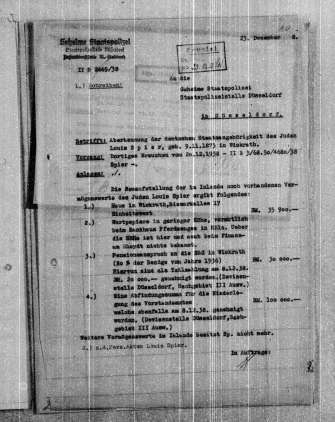 The main points of the document read as follows:
The main points of the document read as follows:
The realignment of the remaining assets within the country of the Jew Louis Spier is as follows:
1 – House in Wickrath, Bismarkallee 17 unit value RM 35,900
2 – Securities of lower amounts, probably at Bankhaus Pferdmenges
in Cologne. We do not know the amount, nor does the finance department
of Rheydt.
3 – Pension claim to the NAG in Wickrath (80% of earning from 1936) RM 30,000
Of these, as partial payment on 8th of December 1938. RM 20,000 –
approved, (foreign exchange office Dusseldorf, Subject Area III Select.)
4 – Termination indemnity for the resignation of the executive office
which also on 8th December 1938 were approved. (Foreign Exchange
Office Dusseldorf, Subject Area III Select.) RM 100,000
Other assets within the country no longer possessed.
And so on the 23 of December 1938 my great grandfather’s life was summed up as being worth 165,900 Reich Marks. Six years later he was murdered at Auschwitz. The Germans had taken everything he had owned and then they took him.
I wondered how my grandmother did it. How did she have the strength to continue to fight? First – to continue to keep up hope after everything had been taken, including her parents. And later, after the war, each deposition and appeal for reparation had to bring back the fear and sadness all over again. Each memo and phone call to a lawyer would have brought the pain of the war and losing so many friends and family members. The effects of war continue years after peace treaties are signed.
Filed under: Holocaust, Memory, Nazi, Prejudice Tagged: Archive in Nordrhein-Westfalen, Holocaust survivor, International Tracing Service, Reparation, Stolen Property, Wickrath








July 2, 2016
Lucky Star

My mother kept the yellow star she had to wear during the war. She never showed it to me. It must have been in the back of a drawer in a dusty envelope. At some point in the mid 70’s she donated it to the Jewish Historical Society of Greater Hartford (JHSGH). What she remembers is that a high school student interviewed her and then the transcript of the interview and the star were donated to the JHSGH.
Fast forward to 2016 and the University of Hartford is preparing a display in their Museum of Jewish Civilization honoring local Holocaust survivors. Mom will be one of the survivors featured in the first round of the exhibit, and so she is trying to track down the star to put in the museum along with her doll and her other 75-year-old artifacts.
I was visiting my parents and Mom told me the historical society can’t find the star. They think they donated it to the JCC (Jewish Community Center), but the JCC says they never had it. Quite the mix-up. I told Mom I would help her track down the missing star. I decided we should call the high school student who interviewed her to see if maybe he remembered it going somewhere else.
She had no idea how to find him but did remember his name. She actually remembered his name wrong but my dad corrected her. (He had done business with the student’s father in the past.) I fired up my computer and opened Google to do some sleuthing. I found the father in Florida. The dad gave me his son’s number in Maryland. Bingo!
When I called Jim there was no answer, but I did leave a voicemail about my mom and the interview and the star. I think I might have mentioned that I’m writing a book about my mom’s experiences during the Holocaust. I don’t remember the message exactly as I tend to babble a bit when I leave voicemail messages.
An hour later Jim called back. Mom was so excited that she barged into the bathroom and handed me the phone while I was in the shower!!! I had to ask her to ask him to wait a second while I grabbed a towel.
So I stood in my childhood bedroom, dripping wet, wrapped in a towel, and talked to Jim about the missing star. He remembered Mom, our house, the doll – but not the star. I was disappointed, but then he asked about my book and when it’s going to come out. I told him I don’t have an agent or a publisher yet and was still tweaking the manuscript into better shape.
I heard another voice and his partner started talking – I had been on speaker phone, and she had been listening.* She told me she was a publisher! All I could say was, “I’m on the phone with a publisher? I’m on the phone with a publisher?” I had done my elevator speech not knowing she was there.
We talked more about the book and she asked me to send it to her. That was May 20th. Now it’s six weeks later and I am holding a publishing contract! And we are going to try to get the book out by April or May 2017!
How many authors can say they found their publisher in the shower? I guess I can thank my lucky star.
(I’m still searching for my mom’s missing star. Hopefully it will turn up in time for the museum opening.)
* Margie assures me that she was waving her hands frantically at Jim trying to get him to tell me that she was in the room too. However, I was talking too much for him to do so without interrupting me.
Filed under: Acceptance, Connections, Giving Thanks, Maurice Greenberg Center for Judaic Studies, University of Hartford Tagged: Jewish Community Center, Jewish Historical Society of Greater Hartford, Publishing, writing








June 29, 2016
Needles in the Haystack
We arrived in Bad Arolsen after dark. Only one other person got off the train with us at the small station and we followed him to the one taxi parked at the curb across the street. The taxi driver was happy to take both fares. As we drove through town, I noticed that everything was pretty well buttoned up for the night. When the taxi dropped us at the hotel, I had my doubts. There wasn’t one light on. The driver must have read my reaction and motioned for us to go around to the back of the building.
Dave and I stood in the dark and rang the bell. It took a few minutes and just before I suggested we sleep on the hotel porch, a light went on and a friendly woman appeared. Her English was worse than my German but we managed to communicate as needed. We went to our room and settled in for the night.
The next morning we were treated to a lovely breakfast – yogurt and muesli, hard boiled eggs and cold cuts, cheese and brötchen (freshly baked rolls). The Hotel, Zum Hollander, was run by a Dutch family who were friendly, helpful, and accommodating. After we were pleasantly full we headed out to find the International Tracing Service (ITS).
The ITS was set up in the late 1940s in order to help find missing persons as a result of persecution and forced labor. For decades survivors of the Holocaust have turned to the ITS to find lost family members or, in most cases, find out the fate of their missing relatives. I went there looking for more. I knew the fate of the people I was researching. I wanted the details – Why? Why not? How?
The ITS has over 30 million documents and to date about 80% have been digitized. From what I had read about the ITS, I assumed that the people there would be unfriendly. I thought they would try to limit my access and make my search difficult. After all, they had been sitting on a gold mine of information since WWII and only opened their files to the public in 2007. I was anxious as we made our way into the building.
We signed in and met the archivist who was to help me with my search. His name was Martin. He was casually dressed in jeans and a polo shirt. He was friendly and patient and helped us understand how the documents were organized and how to use the finding aids to actually find something. The computer system there was confusing to say the least, but Dave and I persevered and were rewarded with a wealth of information. As a matter of fact, since we only had a day and a half set aside, I didn’t take the time to read and translate and understand each document. Many things I simply put in my folder to read later. We didn’t find everything I was searching for, but there was plenty that I hadn’t expected. When we were ready to leave, Martin downloaded my ‘save’ folder to a USB stick. At the end of this post you will find a few of my newly acquired documents.
One document I not find is the transport list from the date my grandfather was supposed to be sent to Auschwitz. I was hoping to be able to see a list with his name crossed out as he had been given last minute dispensation. I was hoping to figure out the exact date that he was facing death and escaped. I wanted to be able to place that chapter in my book in an accurate moment in time. But it was one needle in the haystack that I didn’t find. And, like some of my other unfound needles, it doesn’t really matter. The date is unimportant. What is real and true is that he was on a list, that he thought he would be sent to his death, and that he wept as he said good-bye to his wife and parents and young children.
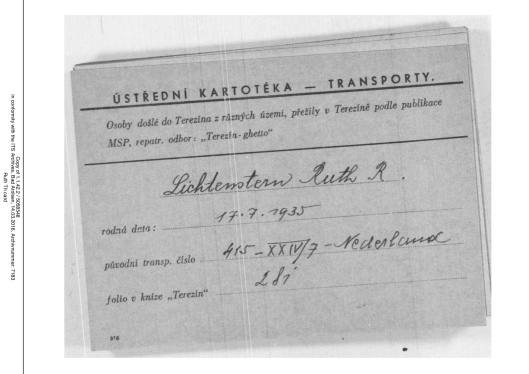
Theresienstadt registration card for my mother with her birth date and transport number

A room list from Theresienstadt showing which barracks my grandparents (# 7 and #8) were assigned to

This one is hard to read, but it is the barracks assignments for my mother and uncle in Theresienstadt
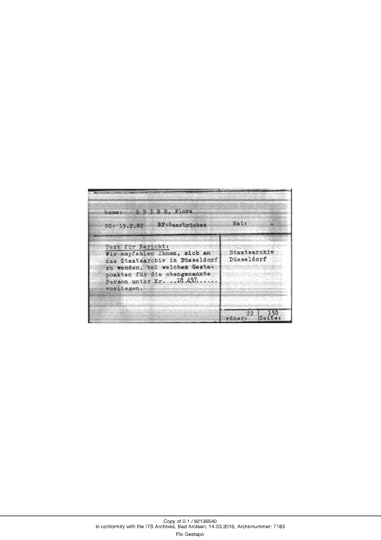
This card tells me that there is a Gestapo file on my great grandmother located in the State Archives (more on this later)!
Filed under: Holocaust, Research, Theresienstadt Tagged: Bad Arolsen, Deportation, Gestapo, International Tracing Service, ITS, Zum Hollander








June 10, 2016
On to Osnabrück
I would like to apologize to my readers for the break from the blog this past month. I needed to do some revisions on my manuscript of Scraps of Hope. Last week, for the first time, I sent it off to be reviewed by a potential publisher. Hopefully, it will be accepted – but I’ll have to wait to find out.
Back to news about the trip to Europe.
After we left Prague on the City Night Line train we spent the weekend in Osnabrück, Germany. Osnabrück was the home of Justus Nussbaum, one of the seven metal Jews. Nussbaum owned a scrap metal yard along with Alfred Gossels, who also appears in some of the “metal Jew” correspondence.
The weekend was highlighted by two events –
1 – a visit to the Felix Nussbaum House (more about that another day) and
2 – my being interviewed for a documentary
About a year ago a received an email through this blog from Mark Mathew. What he told me was astounding:
I am researching a story re my Grandad Wilhelm Hellmeister, who in 1937 in Osnabrück worked for Alfred Gossels and Justus Nussbaum. In July 1937 my Grandad drove Alfred Gossels to the Netherlands. And we have reasons to believe that apart from Alfred, Justus Nussbaum, his wife Sophie and his 2 year old daughter Marianne were also in the car. I would like to find out more, especially about Alfred Gossels, and maybe we can exchange some info.
Mark and I have been exchanging information ever since. He has been working on a docu-drama with he daughter (working title “Escape was in Vain”) about the Nussbaum and Gossels families’ escape from Germany to the Netherlands. His research and mine overlap as we have been trying to figure out how the Germans treated these metal-Jews and why some survived and others did not.
The morning of the filming was intense for me. Mark and his film crew, sound tech, and several still cameras all flitted around me like moths around a candle. I was hooked up with a mic and the cameras started to roll. I do not like being in font of a camera, but after several minutes, I got used to the feeling of being “in the spotlight.” It was an exciting and productive day and I’m looking forward to the final film.
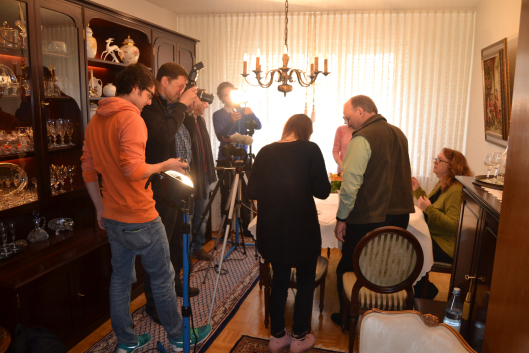
If I look a little overwhelmed, I am!
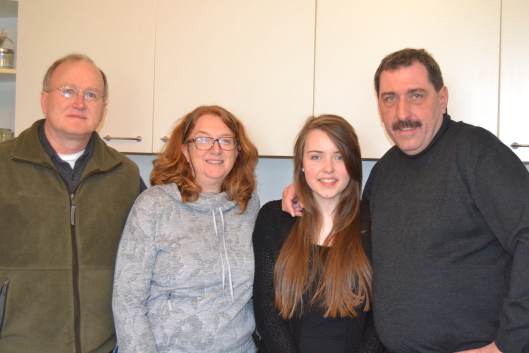
My husband Dave, me, Abigail & Mark
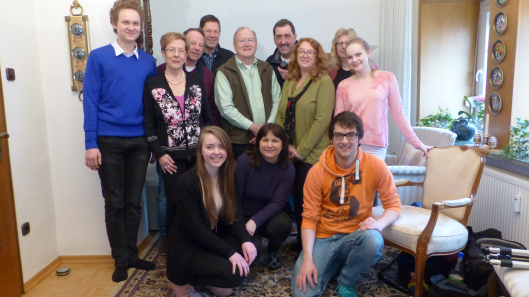
The film crew
Filed under: Blogging, Connections, Netherlands, Research Tagged: connections, Deportation, Felix Nussbaum, Metal Jews, Osnbrück, Scraps of Hope, Westerbork








May 9, 2016
Next Stop – Pilsen
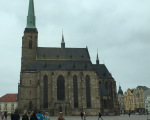

After our emotional day in Terezín we took a day to visit Pilsen (Plzeň), about 50 miles west of Prague. It is a vibrant city (fourth largest in the country) and was given the distinction of being a European Capital of Culture in 2015. Two things that Pilsen is known for are their beer and their place in the history of the end of WWII.
The City of Pilsen has been holding an annual Liberation Festival for the last 26 years to commemorate the end of WWII. According to the Liberation Festival website
As one of the cities liberated in May 1945, it is the last actual and symbolic place where the Allied forces’ journey through the European continent ended; it is a city symbolically linking France, Luxembourg, Belgium and the Czech Republic.
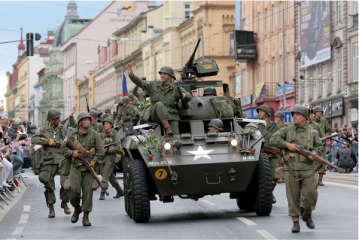
Every year history buffs reenact the liberation of the city and the defeat of the Third Reich. This is done with a complete array of US jeeps, tanks and other military gear and men and women dressing in US Army uniforms of the 1940’s. The citizens there are as serious about the accuracy of their encampments, uniforms and armaments as any US Civil War reenactment club.
Unfortunately we were there well before this past weekend’s festivities. We did, however, visit the Patton Memorial. This museum is filled with memorabilia from and information about the liberation of May 1945. I was hoping to find out something that would help me in locating the soldier I have written about previously, Lloyd Miller, who helped my mother’s family feel human again as they tried to get back to Amsterdam from Theresienstadt after the war’s end.
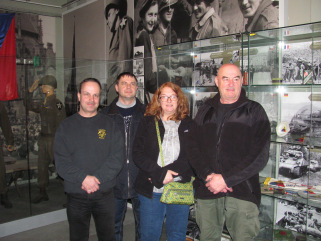
Ivan, Jaroslav, me & Milan
My husband and I met with the owners of the museum, Ivan Rollinger and Milan Jíša, through the help of Jaroslav Kulhánek, who I met via Facebook while doing research. Jaroslav lives in a nearby town and was trying to find out the fate of a certain US soldier whom his grandparents had billeted in May of 1945. The Czech historians and I exchanged some information and upon my return home I was able to track down the widow of Jaroslav’s soldier. He has since written her a letter and is awaiting a response.
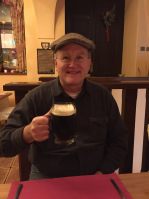
My husband enjoying a Czech beer
I have a couple new clues to work with now, and I’m continuing to search for Sgt. Miller. In the meantime, let’s all raise a glass of Pilsner and say “cheers” or “Na zdraví” to all the veterans of the allied liberating forces.
Filed under: Connections, Plzen, Theresienstadt Tagged: Liberation, Liberation Festival, Lloyd Miller, Patton Memorial, Pilsner, Third Reich, War Reenactment








May 4, 2016
Yom HaShoah
For Holocaust Remembrance Day I am sharing some pictures of my mother’s family members who did not survive Hitler’s hatred and evil.
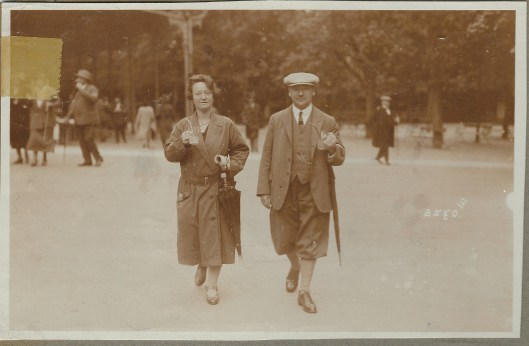
Flora and Louis Spier (my mother’s maternal grandparents)
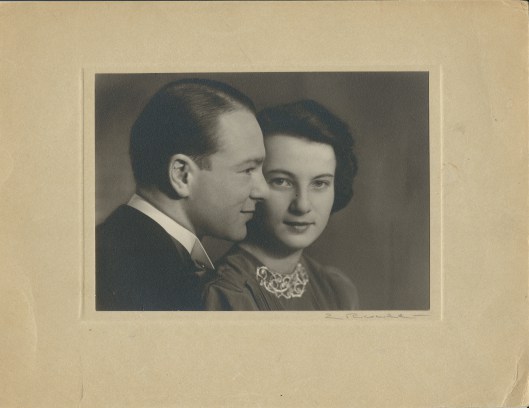
Franz Robert Spier and Justine Spier-Bendien (my mother’s aunt and uncle)
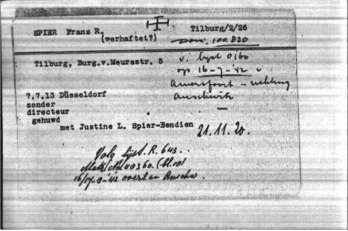
This card tells us that Franz Robert Spier was arrested with Justine Spier-Bendien. It gives us his address and birth date, birth place and profession. And it tells us he died in Auschwitz on the 16th or 14th of August 1942.
Twenty-four year old Justine Spier-Bendien died in Mauthausen on the 19th of March 1945, just thirty-four days before the camp was liberated. She spent over three years as a prisoner and laborer in Scheveningen prison, Ravensbrück, and Mauthausen.
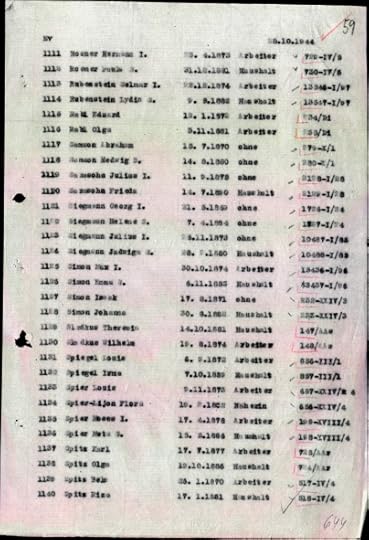
Here is page 59 of transport Ev from Theresienstadt to Auschwitz from the 28th of October 1944. Numbers 1133 and 1134 are Flora and Louis Spier, my great-grandparents.
This also lists their birthdates and the number of the transport they were on when they arrived in Theresienstadt. It lists Louis as a worker and Flora as a seamstress.
They were gassed upon arrival at Auschwitz.
Filed under: Holocaust, Memory, Senseless violence, Theresienstadt Tagged: Remembrance, Yom HaShoah








May 3, 2016
Feeling the Bern*
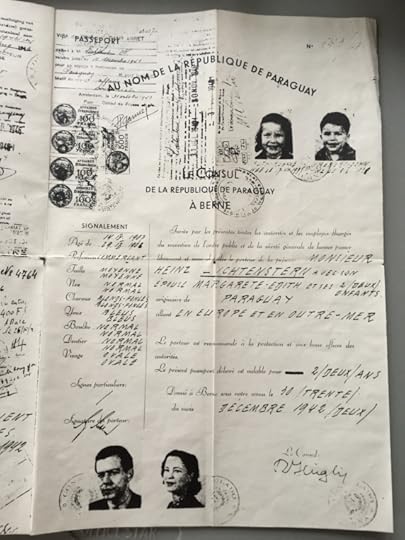
One of the mysteries of my family’s Holocaust survival is their passport from Paraguay. According to my mother, that passport saved her father from a transport to Auschwitz. We have a copy of the document along with a letter of notarization stating that it is real. The mystery here isn’t that the passport exists, but who made the arrangements, how it was obtained, and when it was delivered.
There are differing versions of the story of the passport and I have been trying to figure out which pieces of which account are the most likely.
Here are the various tales:
The passport was forged.
The passport was issued by the Paraguayan consulate for a fee, smuggled out of Switzerland to Germany by a secretary, and mailed from Germany to Amsterdam.
There were two dozen similar passports, but only one made it to our family, while the rest were confiscated by the Germans.
There were thirty-three passports, and all but one made it to their intended recipients.
Because of the passport, my grandfather was released from a Theresienstadt transport to Auschwitz.
My grandfather had been loaded onto the train bound for Auschwitz from Westerbork. At the last minute, someone arrived at Westerbork with the passport and was able to get my grandfather off the transport. The guards then beat my grandfather because he delayed the train.
The truth from seventy-three years ago may never be completely figured out, but today I am one step closer. I know the passport was issued by the Paraguayan consulate in Bern, Switzerland. I also know that at least one of my grandfather’s friends had a passport issued the same day from the same consul. I found a file in Yad Vashem’s Digital Collections entitled “.” The description of the file reads “the documents were issued by the El Salvador Consulate in Geneva and the Paraguay Consulate in Bern.” Yad Vashem will email the digital file as soon as I send the request form and the fee of $15.
What am I hoping to find? How many of the people issued passports by the same consul were friends of my grandfather or worked in the same company? How many of them survived the war?
Every time I find another clue it leads me to some clarity, but also opens new questions. None of this is easy and I will never know exactly what happened. I feel like I am following a path of breadcrumbs. It is fascinating and somewhat addictive. I’ll let you know what I find.
*I am a Bernie Sanders supporter, but this isn’t about him.
Filed under: Addiction, Connections, Holocaust, Memory, Research, Theresienstadt, Westerbork Tagged: Auschwitz, Bernie Sanders, Deportation, Passport, Yad Vashem









